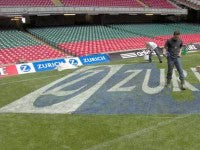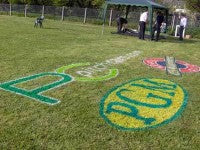The Importance of Good Design
The Importance of Good Design
By Dr Peter Taylor

Paint has been around almost as long as our species and from those earliest days, when our ancestors coated themselves with specially selected earth and powdered rock, so has paint design. Of course things have moved on somewhat since then although the same basic elements and requirements still hold true today. Any paint we design must meet the performance requirements of the customer, be compatible with the preferred application equipment and must be economical to use.
In much the same way, the basic components of the paint, pigment and binder, resemble those used by our prehistoric ancestors, and whereas the animal fat and spit of past times are now replaced by some form of resin, the pigments are still essentially powdered rock.
A modern paint will typically contain the following generic raw materials:-
|
Prime Pigments:
- Organic : - Inorganic: |
Very expensive
Derived from petro chemicals Titanium dioxide, iron oxide |
| Extender pigment: |
Less Expensive
eg. Talc, China clay, calcium carbonate, barium sulphate |
| Binder : | eg. water-based emulsion resin, alkyd, polyester, acrylic, epoxy |
| Solvent : | eg. water, hydrocarbon, oxygenated hydrocarbon |
In addition a group of materials described as additives which are used to:
speed dry, aid pigment dispersion, reduce foaming, introduce structure, prevent surface defects, and other desirable characteristics are also commonly included.
For athletic field marking, the majority of paints are water-based and use either an acrylic or acrylic/vinylic polymer emulsion as binder. The prime pigment is usually titanium dioxide which provides colour and opacity to the paint. The prime pigment is typically very expensive and to make the paint more economical, extender pigments are used. Extender pigments have several functions in a paint formulation such as to provide bulk, augment mechanical and optical performance in addition to reducing the overall cost. The choice of additives is specific to each company and each formulation, as they are often used to balance performance in water-based technology.
Often overlooked is the importance of matching the paint to the equipment used in order to achieve optimum results. Companies who produce both paint and equipment invariably design the two elements to work in harmony. Athletic field marking paint is applied by a number of techniques including airless spray (high and low pressure), spray and wheel-to-wheel transfer. The type of the application technique and the surface to which it is applied defines the physical properties of the paint chosen.
How do we design a paint?
Firstly we ask a number of questions, the answers to which define the performance requirements of the paint. Typical questions include the following:-

How will the paint be applied?
Is the paint ready for use?
What surface is the paint going to be applied to?
If the paint is to be diluted by the customer, what are the dilution guidelines?
How long does the paint need to last in use?
What is the target price?
What is the environmental impact: of the paint, wet film, dry film and packaging?
If we address each of these questions in turn, we can gain an insight into the design process. In a successful company all of these questions must be answered in close consultation with the customer.
What colour? - Usually white although current demand often requires colours for special situations including logos. If we concentrate on white paint we must determine how white. It is possible to measure the amount of light reflected from a coated film of paint and from the measurements calculate the white reflectance (Rw) of the paint. Alongside Rw is the hiding power (HP) or opacity of the paint. This is a measure of how readily the paint film will obliterate the underlying surface (usually grass). If the paint has low opacity it will allow the colour of the grass to show through and darken the perceived colour.
For convenience, comparative measurements are made on paints by applying a set film thickness to a special card which is half black and half white. A comparison of measurements taken from the film over the black and white sections gives figures for Rw and HP. Both Rw and HP are important in producing the required quality of line.
How will the paint be applied? - The key property of the paint that affects application is viscosity. Viscosity is a measure of the 'gloopiness' of the paint so that a thin, watery paint has a low viscosity whilst a thick paint has a high viscosity. For transfer wheel application the paint should be thick enough to stick to the transfer wheel in an even film, too thin the wheel will not pick it up and too thick it will stop the wheel from going round. Spray application usually requires lower viscosity at the point of application.
Is the paint ready for use? - It is common practice to supply spray applied paint as a concentrate that can be diluted (according to manufacturers guidelines) to an appropriate viscosity by the addition of water. Paint for transfer wheel application is more commonly supplied ready for use.
What surface is the paint going to be applied to? - All too often overlooked is the type of surface to be coated. Lines intended for hard surface applications are designed to be more mechanically robust than those intended for grass. As all Groundsmen know only too well, the variation in quality of grass surfaces is significant with the proportion of grass to broadleaf species and even bare earth being key factors. A well designed paint will cover grass, broadleaf species and bare earth in a consistent manner. Formulations that do not often result in a patchy, oddly 'diseased' appearance.
If the paint is to be diluted by the customer, what are the dilution guidelines? - It is important that the paint when diluted (often to extreme proportions) both mixes well and when mixed, resists settlement during use. Some poorly designed paints do neither, making them difficult to use and therefore increasing the time and cost of marking out. The proportion to which the paint may be diluted in practice will depend on the amount of pigment it contains and the quality of the line required. Better quality paints usually contain more pigment per litre than budget paints. Although per litre this means they cost more, they are capable of higher dilutions and may work out more cost effective for the same quality of line than a cheaper grade. These better quality paints give more opaque, whiter lines for a given dilution when compared to cheaper alternatives. Typical dilution rates are 2:1 to 8:1 (parts of water to parts of paint, volume: volume) although some exceptional paints give good lines at dilutions of up to 10:1 and even 20:1.
How long does the paint need to last in use? - This is always a difficult question to answer. The longevity of a line is determined by a complex and unpredictable combination of factors making the design of this area quite tricky. The level of pigmentation and the resin emulsion employed are key determinants of longevity. The factors that need to be considered include grass growth rates, rainfall, temperature, usage levels and marking frequency.
What is the target price? - This question has two sides to it. Firstly, the price charged to the customer must reflect the cost of the raw materials, the development time and the other manufacturing costs. Secondly, it is important that the product is pitched (no pun intended) at the correct market sector. It is pointless to design a product slightly better than others in the market place if it costs 3 times the price due to exotic raw materials.
 An increasingly important factor in the design process and one which many manufacturers tend to neglect. The formulation should not, in the case of coatings for grass surfaces, result in harmful build-up as a result of repeated use. Products such as those supplied by Fleet (Line Markers) Ltd. are formulated with pH values (acidity/alkalinity) close to neutral (water) and are less likely to disrupt the natural pH balance of the surrounding soil. Many manufacturers still manufacture formulations with higher (more alkaline) pH values.
An increasingly important factor in the design process and one which many manufacturers tend to neglect. The formulation should not, in the case of coatings for grass surfaces, result in harmful build-up as a result of repeated use. Products such as those supplied by Fleet (Line Markers) Ltd. are formulated with pH values (acidity/alkalinity) close to neutral (water) and are less likely to disrupt the natural pH balance of the surrounding soil. Many manufacturers still manufacture formulations with higher (more alkaline) pH values.
It is worth spending a little time discussing the relative merits of commonly used ingredients found in athletic field marking paints.
Titanium dioxide is almost exclusively the choice of white pigment, there are many grades with many characteristics and prices can vary from around £500 per tonne to £2500 per tonne. A formula will use a specific titanium dioxide. One cannot jump to the conclusion that one paint is better than another solely because it has a higher percentage of titanium dioxide. This is a common way that some athletic paint manufacturers market their paints, the customer must consider the paint as a whole. Sometimes a smaller proportion of a high performance titanium dioxide will out perform a higher percentage of a cheaper titanium dioxide.
The commonly used extenders are China clay, calcium carbonate and talc. Each of these raw materials has its own combination of strengths and weaknesses (whiteness, pH, etc.) and manufacturers make their choices based on their perceptions of these properties. The largest volume manufacturer of athletic field marking paints (Fleet Line Markers Ltd) recognises that calcium carbonate and China Clay are both quality extenders and chooses the optimum extender or combination of extenders to maximise the performance of their paints. There is considerable variation in quality within each family of extenders and likewise the cost exhibits similar variation. Larger manufacturers can therefore pass the benefits of bulk purchasing power on to the consumer without compromising the quality of product.
The binder (resin) used in these products is generally some type of acrylic emulsion which combines good performance with moderate cost. Some are more sensitive to damage as a result of freezing or exposure to heat and produce paints that are more sensitive to storage conditions. Almost all resins used today are derived from oil and are to some extent tied to the fluctuations in the price of oil.
It is worth briefly mentioning 2 of the additive types often found in these paints. The rheology of the paint is adjusted by the use of thickeners. These come in a bewildering range of chemical types, some of which are more suitable than others. It is a commonly held misconception that thick (viscous) paint represents better value than thin paint. It is possible to artificially boost the viscosity of a paint with relatively low levels of pigmentation to give the impression of better value for money.
Our prehistoric ancestors, with their early paints, began the journey of development that still continues today. As paint producers we are always seeking to improve performance, value for money, innovate and comply with the legislative framework of modern society. Paint might be a tedious topic to most people, but just ask yourself what kind of world would we live in if paint did not exist?
